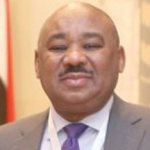Sudan has been devastated by a high intensity factional military conflict over more than a year. Unfortunately, the worst is still to come should it escalate into a large scale long-duration ethnic war. We show in this paper that this is a distinct possibility in view of the country’s highly fractionalized society. Using a Long-term Growth Model for Sudan, we find that the country could lose more than $2.2 trillion relative to a modest counterfactual peacetime scenario with a 4% annual growth rate. Realization of the conflict scenario could very well pose an existential threat for the country and its territorial integrity. Ending this war before it scales up and building sustainable peace is an absolute imperative for Sudan that requires a robust political settlement, leading to a transformative civil-democratic transition. Given the war-ravaged social capital and diminished domestic capabilities, sustainable peacebuilding requires a multi-dimensional UN-Regional peacekeeping operation for Sudan, guided by a broad civilian democratic coalition. While UN missions could help improve the “quality” of peace building, longer-term sustainability requires sustained, transformative, broad-based economic growth. The emerging political order, therefore, should be accountable for achieving development and prosperity, not just majorities in the electoral competition. Under such developmental democratic civil peace, we predict “miracle” growth for Sudan. In an era of relocalization and concerns about food security, the vast Sudanese agricultural resource base provides a magnet for inward FDI flows that will help deliver the envisaged growth.
مخلص
يشهد السودان صراعاً عسكرياً فصائلياً شديد الوطأة منذ أكثر من عام. ولسوء الحظ، لا يزال الأسوأ قادماً في حال تصاعدت الأمور إلى حرب إثنية واسعة النطاق وطويلة الأمد. نبين في هذه الورقة البحثية أن هذا يظل احتمالاً مرجحاً، بالنظر إلى الانشطارات المجتمعية الهوياتية التي تطبع المجتمع السوداني والاستقطاب السياسي الماثل. وباستخدام نموذج نمو طويل الأجل للسودان، نجد أن البلاد يمكن أن تخسر أكثر من 2.2 تريليون دولار أمريكي مقارنةً بسيناريو متواضع في زمن السلم بمعدل نمو سنوي يبلغ 4%، مما يشكل تهديداً وجودياً للبلاد وسلامة أراضيها. إن إنهاء هذه الحرب قبل توسع نطاقها وبناء سلام مستدام هو ضرورة حتمية للسودان تتطلب تسوية سياسية متينة، تؤدي إلى انتقال مدني ديمقراطي تحويلي. وبالنظر إلى تهتك رأس المال الاجتماعي الذي دمرته الحرب وتراجع القدرات المحلية، فإن بناء السلام المستدام يتطلب عملية أُممية متعددة الأبعاد من الأمم المتحدة لحفظ السلام في السودان، بتوجيه من تحالف مدني ديمقراطي يحظى بإجماع شعبي واسع. وفي حين أن بعثات الأمم المتحدة يمكن أن تساعد في تحسين "نوعية" بناء السلام، إلا أن الاستدامة على المدى الطويل تتطلب نمواً اقتصادياً مستداماً وتحويلياً عريض القاعدة. ومن ثم، ينبغي أن يكون النظام السياسي الناشئ مسؤولاً عن تحقيق التنمية والازدهار، وليس فقط تحقيق الأغلبيات في المنافسة الانتخابية. في ظل هذا السلام المدني الديمقراطي النهضوي، نتوقع تحقيق نمو "معجزة" للسودان. وفي حقبة إعادة التوطين والمخاوف بشأن الأمن الغذائي، توفر قاعدة الموارد الزراعية السودانية الشاسعة نقطة جذب لتدفقات الاستثمار الأجنبي المباشر والتي ستساعد بدورها في تحقيق النمو المتوخى.

Research Fellows
Ibrahim Elbadawi
Development Studies & Research Forum, Dubai

Authors
Federico Fiuratti
Consultant, The World Bank


